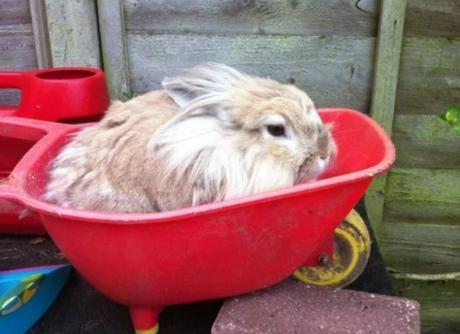A wheelbarrow is one of the most essential tools for both gardeners and DIY enthusiasts. Whether you’re hauling soil, bricks, or garden waste, using a wheelbarrow correctly can save you time and energy and even prevent injury. So before you rush out and discover the largest range of wheelbarrows, we take a look at ten must-know tips to ensure you get the most out of your wheelbarrow and make your tasks a little bit easier, and we get to enjoy some fun pictures of animals in wheelbarrows along the way.

1. Choose the Right Wheelbarrow for Your Needs
Not all wheelbarrows are created equal. The type of wheelbarrow you need depends on the job at hand. A lightweight plastic wheelbarrow with a single wheel may suffice for small garden tasks. For larger, heavier loads—like moving stones or bricks—a sturdier metal option with dual wheels will provide more stability and control.
Consider the size, weight, and material of the wheelbarrow. Metal wheelbarrows are more durable for regular, heavier loads, but they are also heavier to push. On the other hand, plastic versions are lightweight and easier to maneuver but less suited to carrying heavy loads.

2. Distribute Weight Properly
One of the most common mistakes when using a wheelbarrow is improper weight distribution. Loading the front too heavily or too far back makes controlling the wheelbarrow difficult and increases the risk of tipping over.
The key to smooth wheelbarrow use is balance. Position heavy items closer to the wheel, evenly spreading the load across the barrow. This helps keep the center of gravity low and makes pushing much easier.

3. Maintain Tyre Pressure
Flat or under-inflated tyres can make pushing a loaded wheelbarrow far more strenuous than it needs to be. Before tackling any big jobs, check your wheelbarrow’s tire pressure. Pneumatic tyres need regular inflation, while solid rubber tyres are maintenance-free but may not provide the same cushioning on rough terrain.
Maintaining proper tire pressure ensures smoother manoeuvrability and reduces strain on your body when pushing heavy loads.

4. Use Proper Lifting Technique
Lifting a loaded wheelbarrow the wrong way can lead to back injuries or muscle strain. Always lift with your legs and not your back. Bend your knees, grab the handles, and use your leg muscles to raise the wheelbarrow upright. Keep your back straight and engage your core muscles when pushing to help with stability and control.
Avoid the temptation to hunch over or use your upper body alone to move the barrow—this can quickly lead to fatigue or injury.

5. Navigate Uneven Terrain Carefully
Gardens and outdoor areas often come with uneven ground, soft soil, or rocky paths. These can be tricky to navigate with a fully-loaded wheelbarrow. Push the wheelbarrow slowly and steadily when moving across slopes or rough terrain to maintain control.
If you’re tackling a particularly challenging patch, consider using boards or ramps to help get the barrow over rough or uneven areas. Slow, controlled movements will help prevent spills and keep your load balanced.

6. Avoid Overloading the Wheelbarrow
While it might be tempting to pile everything into one trip, overloading your wheelbarrow can lead to accidents and damage. A wheelbarrow that’s too full is harder to control and more prone to tipping. Over time, regularly carrying excessive weight can wear down the wheelbarrow itself, leading to frame damage or flat tyres.
Stick to manageable loads that you can comfortably push without straining. This will make the job easier and help your wheelbarrow last longer.

7. Clean Your Wheelbarrow After Use
It’s easy to finish a task and leave your wheelbarrow sitting in the garden, but taking a few minutes to clean it will make a big difference in the long run. Mud, soil, and plant debris can build up, causing metal barrows to rust or plastic ones to degrade.
Give your wheelbarrow a quick rinse after each use, especially if you’ve been handling wet soil, manure, or concrete. This will prevent build-up and keep your wheelbarrow looking and working like new for longer.

8. Store Your Wheelbarrow Properly
Proper storage is crucial for maintaining your wheelbarrow. Leaving it to the elements will lead to rust, deterioration of tyre, and general wear and tear. If possible, store your wheelbarrow indoors, like in a shed or garage. If that’s not an option, cover it with a waterproof tarp to protect it from rain and sun.
Consider using wall hooks to hang your wheelbarrow off the ground for extra space-saving. This also prevents tire deformation from prolonged pressure on one side.

9. Grease Moving Parts
The axle is the heart of your wheelbarrow’s movement, so keeping it in good condition is important. Applying grease to the axle and other moving parts will ensure smooth operation and reduce wear.
To grease the axle, first clean away any dirt or debris. Apply a small amount of grease, and make sure it’s evenly distributed. This will make the wheelbarrow easier to push and extend its life by preventing rust and friction damage.

10. Use Accessories to Improve Efficiency
There are many accessories available to make wheelbarrow use even easier. For example, you can attach tool organisers to the sides of your barrow, keeping your spade, trowel, or secateurs within easy reach. For larger jobs, bucket trays can be added, allowing you to separate materials like soil, gravel, or plants.
Customising your wheelbarrow with the right accessories can make it more versatile and help you tackle tasks more efficiently.
A wheelbarrow is a simple yet powerful tool, and by following these 10 tips, you can maximise its efficiency and longevity. Whether you’re gardening, landscaping, or working on a home project, using and maintaining your wheelbarrow properly will make the work much easier—and save you from unnecessary strain. So, the next time you grab your wheelbarrow, remember these tips and enjoy smoother, more productive tasks ahead.

